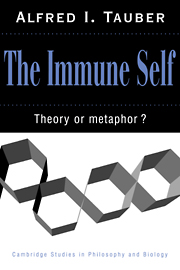Book contents
- Frontmatter
- Contents
- Acknowledgments
- Introduction
- 1 The phagocytosis theory
- 2 The triumph of immunology
- 3 The immune self declared
- 4 From theory to metaphor
- 5 Immunology gropes for its theory
- 6 The self and the phenomenological attitude
- 7 The self as organism: A philosophical consideration
- 8 The search for identity
- Notes
- References
- Index
1 - The phagocytosis theory
Published online by Cambridge University Press: 14 January 2010
- Frontmatter
- Contents
- Acknowledgments
- Introduction
- 1 The phagocytosis theory
- 2 The triumph of immunology
- 3 The immune self declared
- 4 From theory to metaphor
- 5 Immunology gropes for its theory
- 6 The self and the phenomenological attitude
- 7 The self as organism: A philosophical consideration
- 8 The search for identity
- Notes
- References
- Index
Summary
ELIE METCHNIKOFF
Fin-de-siècle Europe was difficult for its citizens to define: “Fin-desiecle! Everywhere it stands for all that you might care to name ” (quoted by Weber 1986, p. 9; see also Schorske 1979; Kern 1983; Dowling 1986). In the midst of social and cultural upheaval, the subject of Man was being redefined. This period witnessed the publication of William James's Principles of Psychology (1890), Ernst Mach's Contribution to the Analysis of the Sensations (1886), Freud's Interpretation of Dreams (1900), and Nietzsche's Beyond Good and Evil (1886). Ibsen produced Hedda Gabler (1890), and Cezanne and van Gogh were radicalizing the visual arts. New artistic freedom, in what Oscar Wilde epitomized as the full expression of personality (with a curious brand of individualism, antibourgeois socialism, and exploration - or better, exposure - of forbidden areas of thought and behavior), has been dubbed an era of decadence or, more kindly, la belle époque (Shattuck 1969; Ellman 1987, p. 305) It was a period of rapid imperialistic colonization of Africa and Asia and of French-German rivalry in Europe, while America was quietly looming as the economic giant, already the source of nearly a third of the world's production by 1888. Around that same year, the first beauty contest was held in Spa, Belgium, Barnum and Bailey's circus opened, cocaine began to be used regularly as an anesthetic, fructose was synthesized, and the term chromosome was first used. The Tenth International Congress of Medicine opened on August 4, 1890, in Berlin's Circus Renz, the only hall large enough to hold the seven thousand participants.
- Type
- Chapter
- Information
- The Immune SelfTheory or Metaphor?, pp. 15 - 43Publisher: Cambridge University PressPrint publication year: 1994



